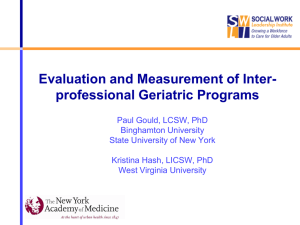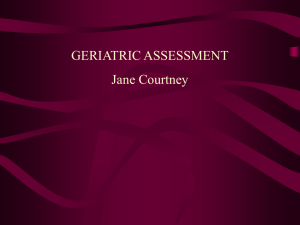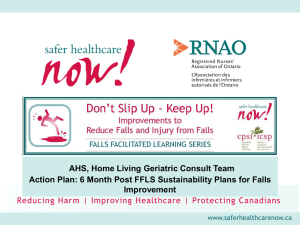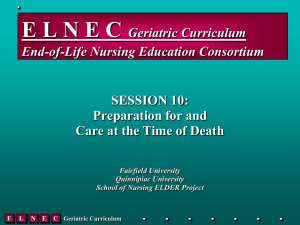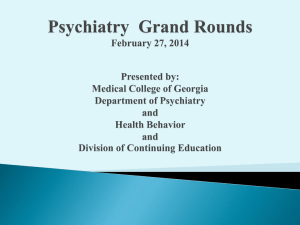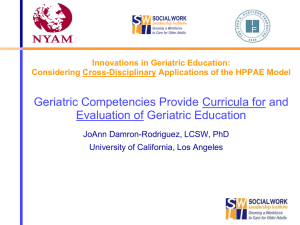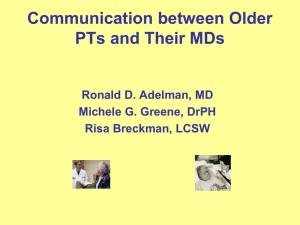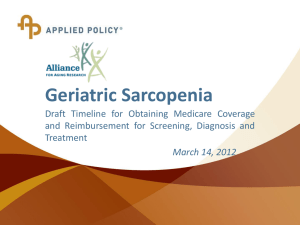Emergency Department Approach To The Geriatric Patient
advertisement
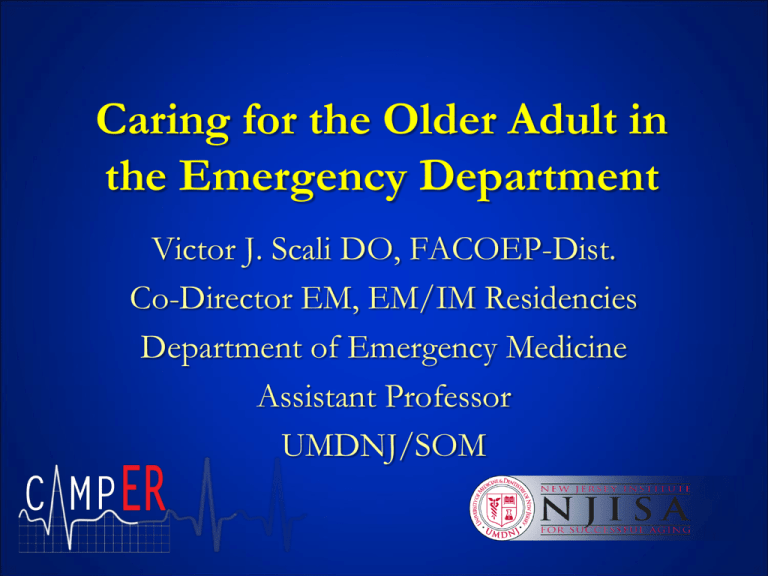
Caring for the Older Adult in the Emergency Department Victor J. Scali DO, FACOEP-Dist. Co-Director EM, EM/IM Residencies Department of Emergency Medicine Assistant Professor UMDNJ/SOM Caring for the Older Adult in the Emergency Department This Care of the Aging Medical Patient in the Emergency Room (CAMPER) presentation is offered by the Department of Emergency Medicine in coordination with the New Jersey Institute for Successful Aging. This lecture series is supported by an educational grant from the Donald W. Reynolds Foundation Aging and Quality of Life program. Question One Which of the following medications can negate the lipid lowering effect of statin therapy in the elderly? (A) Aspirin (B) Ferrous sulfate (C) Interferon (D) Metoprolol (E) Phenytoin Question Two A Gait Timed Get-Up-And-Go Test between 10 and 20 seconds for an elderly patient who arrived ambulatory in the ED indicates: (A) Frailty (B) Independent living ability (C) Minimal fall risk (D) Mortality greater at one year (E) The need for motorized chair Question Three Which of the following DOES NOT predict repeat ED visits or hospitalizations when using the Triage Risk Screening Tool in the ED? (A) Difficulty walking or transferring (B) ED use in previous 30 days (C) Five or more meds are taken (D) Living alone (E) Recent falls The Perfect Storm • Fragmented, overburdened U. S. healthcare system » plus • Rapid growth of elder population » plus • Medicare system approaching bankruptcy » plus • Lack of geriatric emergency medicine training and research Presentation Goals • Discuss an emergency medicine physician’s informed approach to the geriatric patient • Discuss the demographics of this population group • Discuss quality care in the ED and strategies that will decrease hospital morbidity and mortality • Discuss strategies to meet the future crisis in elder care • Discuss effective ED transitions of care for geriatric patients ED Patient Population Demographics • Total ED visits = 130,000,000 in 2007 • Total hospital EDs = 4,500 – 7% decrease in total EDs in USA in 2008 • Total uninsured patients = 47,000,000 in 2008 ED Patient Population Demographics • 2003 ACEP/Robert Wood Johnson Foundation Survey of ED Physicians – 33% patients uninsured – 51% of EDs operating over normal capacity on weekdays, 70% on weekends – 97% felt uninsured patients used ED because of lack of access to primary care – 93% stated uninsured patients had no access to meds for HPT/DM – 93% stated patients can’t get follow-up specialty care for serious conditions Institute of Medicine’s Report: Hospital-Based Emergency Care: At The Breaking Point (2006) “The emergency medicine system is highly fragmented, under funded, and overburdened.” – Overcrowding – Ambulance diversion – Inadequate surge capacity for disasters Image Source: Microsoft Images Geriatric Emergency Medicine Issues • Where we are going? – 2006 IOM report addressed pre-hospital and emergency pediatric care short falls – Future effects of aging population on emergency care not addressed – SAEM addressed the future in article on geriatric emergency medicine (Acad Emerg Med 2006;13(12):1345-1351.) Demographics of Our Aging Population • 2011: Baby Boomers start turning 65 • 2011: 13% of population age 65 (45 million people • 2030: 20% of U.S. population age 65 (70 million people) - Fastest growing subset = >85 Demographics of Our Aging Population • Differences between future >65 population and past: - Better educated Less poverty Fewer children More ethnic/racial diversity SAEM Report on Geriatric Emergency Medicine Key Findings, Part 1 • Pre-ED, EMS personnel lack training in transporting older adults • Between 1993 and 2003, geriatric patient visits to ED 26% • By 2030, geriatric patients will total 25% of ED visits SAEM Report on Geriatric Emergency Medicine Key Findings, Part 2 • Older adults are: – – – – More vulnerable to disasters More susceptible to infectious diseases Less physiologic reserve Drug therapy difficult • Geriatric patients in ED require: – – – – – More time More tests More acute treatment More frequent admissions More ICU admits Healthcare For An Aging Population Challenges • Surge in older adult population has long been predicted, but: – U.S. healthcare system ill-prepared • Size of healthcare workforce inadequate • Training/education in geriatric medicine inadequate – Older Americans continue to consume more healthcare services than young adults – Healthcare needs more complex – Medicare may be insolvent by the time all baby boomers reach age 65 in year 2030 Solutions? The Domain Management Model • DMM 1. Medical / Surgical Issues (The Body) – Biomedical model: Diseases and syndromes • DMM 2. Mental Status, Emotions and Coping (The Mind) – Cognition, emotions, coping, spirituality • DMM 3. Physical Function (Activities) – BADLs, IADLs, AADLs • DMM 4. Living Environment (Surroundings) – Living arrangements, social, financial Siebens H. Acad Emerg Med 2005;12:162-168. Solutions? DMM & Identifying of Seniors at Risk (ISAR) Questionnaire • DMM 1. Medical /Surgical Issues + ISAR Questions – 6. Do you take more than three different medications every day? – 3. Have you been hospitalized for one or more nights during the past 6 months (excluding a stay in the Emergency Department)? • DMM 2. Mental Status + ISAR Questions – 4. In general, do you see well? – 5. In general, do you have serious problems with your memory? • DMM 3. Physical Function + ISAR Questions – 1. Prior to this illness/injury, did you need help on a regular basis? – 2. Because of the illness or injury that brought you to the Emergency Department, will you need more help than usual to take care of yourself ? McCusker J, et al. J Am Geriatr Soc 1999;47:1229–1237. Solutions? DMM and Triage Risk Screening Tool (TRST) • DMM 1. Medical /Surgical Issues – 1. Five or more medications? – 2. ED use in previous 30 days or hospitalization in previous 90 days? • DMM 2. Mental Status – 3. History or evidence of cognitive impairment (poor recall or not oriented) • DMM 3. Physical Function – 4. Difficulty walking / transferring or recent falls? • Other – 5. Triage person’s professional appraisal Meldon SW, et al. Acad Emerg Med 2003;10(3):224-232. Caveats of DMM Adaptation to ISAR & TRST • ISAR – Identifies ED geriatric patients at risk for adverse health and functional outcomes 6 months post-ED visit – Predicts repeat visits to ED in 30 days or 3 times in 6 months • Sutton, et al. reported good test-retest reliability (Int J Clin Pract 2008;62(12):19001909) • TRST – Predicts repeat ED visits and hospitalizations in 30 days and admissions to extended care facilities • TRST means of 2 or more: sensitivity 62%, specificity 57% Question Three Which of the following DOES NOT predict repeat ED visits or hospitalizations when using the Triage Risk Screening Tool in the ED ? (A) Difficulty walking or transferring (B) ED use in previous 30 days (C) Five or more meds are taken (D) Living alone (E) Recent falls Uniqueness of History Taking • • • • • • • • Chief complaint HPI Sample history ROS Family history Social history Domicile Degree of mental and physical functionality at baseline • Family interview Uniqueness of History Taking, Cont’d • Family physician • Transfer sheets on ECF patients woefully inadequate • Devices are disease markers: pacemakers, AICD, Permcath • Time sensitive chief complaints – – – – Acute STEMI requiring emergent PCI Stroke symptoms: Ischemic events and TPA Active GI bleeds vulnerable to shock Abdominal pain: AAA, ischemic bowel, perforated viscus Caveats of ED History • Identify Frailty – Anticipate impact of hospitalization on cognition and function • Sun-downing in past? – Screen ADLs for functional decline – Screen for cognitive decline Image Source: Microsoft Images History: Functional Screening • Gait Timed Get Up and Go Test (TGUG) on ambulatory patients – Instructions to patient: • • • • Rise from chair Walk 10 feet Turn around and walk back to the chair Sit down – Test results: • Normal <10 seconds • Frail <20 seconds • Needs PT >20 seconds – Results correlate with falls risk, ECF placement, ADLs History: Functional Screening • Activities of Daily Living (ADLs) - Bathing Dressing Transfers Toileting / Continence Self feeding • Instrumental Activities of Daily Living (IADLs) - Uses phone Travels Shops Cooks Does housework Manages money Self administers meds • Advanced Activities of Daily Living - Still works Volunteers Does heavy housework Recreation Question Two A Gait Timed Get-Up-And-Go Test between 10 and 20 seconds for an elderly patient who arrived ambulatory in the ED indicates: (A) Frailty (B) Independent living ability (C) Minimal fall risk (D) Mortality greater at one year (E) The need for motorized chair Hospital Discharge Outcomes & Functional Decline • At risk on admission, worse at discharge – Cognitive and functional impairment, pressure ulcers, depression, low social activity • Pre- morbid risk for further functional decline – Co-morbidities, age>80, sensory impairment, frequent hospital admits, psychosocial issues • Outcomes of hospitalization – More ECF placement, frequent readmissions, caregiver stress, increased mortality – Higher expense and higher home service consumption – Iatrogenic complications in 33% of patients Physical Examination • Focused primary survey on patients in extremis • When emergent patient stabilized, more detailed examination should be done • Caveats of the geriatric physical examination – – – – – Degree of personal hygiene Evidence of incontinence Decision making capacity Signs of trauma, gait instability, or elder abuse Pressure sores, skin breakdown Physical Examination • Careful physical examination reveals positive findings – – – – – – – – – Fundoscopic changes Bruits, pulsatile masses Heart murmurs Lungs: Rales, ronchi, wheeze Peripheral edema, stasis changes Skin changes: Ecchymosis Surgical scars Tattoos: Rads therapy Indwelling devices present Diagnostic Workup “Seek And Ye Shall Find” • ED visits rarely limited to Accucheck, pulse ox, EKG, and vital signs • Multiple co-morbidities tend to expand the differential diagnosis and workup – CT scans of head, neck, chest, abdomen, pelvis, spine – MRI – Ultrasound Doppler ED Treatment Tends To Be… • Complicated – Multi-system involvement • Expensive – Imaging: CT, MRI, Ultrasound/Doppler, Nuclear scans • Invasive – Central line placement, intubation • Dangerous – Anticoagulation, pressors, anti-arrythmic agents, procedural sedation Treatment success ultimately depends on premorbid level of conditioning and nutritional status Drug Therapy in ED & During Hospitalization • Identify risk of polypharmacy – Ziploc bag size evaluation key! • • • • Pint Quart Gallon Shopping bag Drug Therapy in ED & During Hospitalization • Identify adverse reactions to medications and toxicity as cause of ED visit – – – – – – – – – – – Digitalis in renal insufficiency Aricept: Dehydration due to diarrhea Vancomycin: Hearing loss Lincosides, cephalosporins: c. diff. colitis Quinolones: Seizures, tendon rupture Chemotherapy: Leukopenia, anemia, thrombocytopenia Coumadin: Serious bleeding, GI, epistaxis, ICH Herbal meds Neuroleptic agents: QT prolongation, arrhythmias Benzodiazepines in Dementia patients: Disinhibition SSRI’s: Serotonin syndrome and agitation Drug Therapy in ED & During Hospitalization • Know aging pharmacology when prescribing medications in ED – Medications that induce cytochrome P450 may inactivate/negate therapy with other meds metabolized by this system • Example: phenytoin and statin for cholesterol Drug Therapy in the ED & Hospital • Medications – Adverse drug events (ADE) = 11% of ED visits – ADE = 12% of ED admissions – ADE’s cost U.S. healthcare system = $76 billion annually – Average elder takes 4-8 meds • Consumes 30% of all written prescriptions – Post hospitalization adds at least one new med – EM physicians have limited knowledge of aging physiology’s effect on meds prescribed Question One Which of the following medications can negate the lipid lowering effect of statin therapy in the elderly? (A) Aspirin (B) Ferrous sulfate (C) Interferon (D) Metoprolol (E) Phenytoin Transitions of Care Begin in the ED ED EVALUATION Discharge Home Admit to Hospital Discharge home ECF Placement Sub-acute Rehab Home with RX Home with Services (PT, OT, VRN, Hospice) Adapted from CHAMP, Ideal Hospital D/C (Catherine DuBeau, MD). Used by permission. Transitions of Care Begin in the ED ED EVALUATION Discharge Home Observation Medicine Admit to Hospital Discharge home ECF Placement Sub-acute Rehab Home with RX Home with Services (PT, OT, VRN, Hospice) Adapted from CHAMP, Ideal Hospital D/C (Catherine DuBeau, MD). Used by permission. Appropriate ED Discharge Before discharging an elderly patient home from the ED, ask: • Is ADL baseline stable or can ADL independence be recovered easily at home? • Are there sufficient/willing caregivers available to assist transition? • Are meals and medication(s) supervision available, if needed? – Has medication list been reconciled? • Is the home a safe environment and disability friendly? • Is primary medical care available for follow-up? • Are any home services (PT, OT, VRN) needed? Adapted from CHAMP, Ideal Hospital D/C (Catherine DuBeau, MD) Post-ED Disposition Transitions of Care • ED visit now Day 1 of hospitalization! • Admitted elders most often require higher level of care (PCU, CCU, ICU) • Hospital course protracted & complicated • Elders admitted with serious illness often require higher levels of care than baseline on discharge – Inevitable cognitive and functional decline Consider Hazards of Hospitalization in Your ED Disposition • Delirium: Disturbance of consciousness and attention – Assess risk of delirium during anticipated hospitalization • Deconditioning – Serious consequence of bed rest, so mobilize early • Depression – Underdiagnosed in elders, so screen for it • Dementia – Undiagnosed in geriatric ED admission – Decision making capacity – Hypoactive delirium in ECF patients misdiagnosed as depression Hazards of Hospitalization, Cont’d • Fall risk? • Foley catheter placement – Avoid placing for nursing convenience – Placed in ED only for CBI, urinary retention, therapeutic diuresis, and to monitor output in shock states – Remove as soon as possible • Wound Care – Document pressure-induced wounds and staging present on admission – Inform admitting physician of need to address – Prevention is the best treatment Ethical & Social Challenges For ED Transitions of Care • ED = key venue for realistic end-of-life planning • Refocus families on loved one’s lack of: – Quality of life – Suffering – Impossible recovery • • • • DNR/DNI/DNH Palliative care Hospice Social workers and case managers Initiating Higher Level Transitions of Care in the ED: Pain Management • Use numeric pain scales when possible • Recognize pain in dementia patients • Use opiates and non-opiates properly • Manage opiate side effects Image Source: PhotoDisc® Health & Medicine – Nausea – Pruritis – Hypotension Initiating Higher Level Transitions of Care in the ED: Palliative Care • Discuss prognosis & care plan with family • Emphasize palliative care for patients with advanced disease • Clarify existing Advance Directives & discuss DNR Image Source: Microsoft Images Initiating Higher Level Transitions of Care in the ED: Palliative Care Image Source: Microsoft Images • Avoid repetitive diagnostics / invasive treatment when risks & discomfort outweigh benefit • Treat non-pain symptoms • Cardiac arrest survivors The Future of Emergency Care for Geriatric Patients: Recommendations Pre- Hospital Care • EMT’s: 110 hour course with anatomy, physiology, airway, splinting, transport, c-spine precautions, etc. • Paramedics: EMT training + advanced skills (ETT, defibrillation, medications) • Pediatric focus: 4% of patients, vulnerable, EMSC driving force for education • No specific geriatrics training, but 100-167/1000 use rate The Future of Emergency Care for Geriatric Patients: Recommendations Pre- Hospital Care • GEMS (Geriatric Education for EMS) – Developed by AGS & EMT Training Coordinators Council – Available to states • Safe, high quality care only assured through: – Education – Equipment changes – Procedural changes The Future of Emergency Care for Geriatric Patients: Recommendations Disaster Planning • Geriatric patients more vulnerable in both natural and man-made disasters – Hurricane Katrina • 70% of dead > age 60 – 2004 Indian Ocean Tsunami The Future of Emergency Care for Geriatric Patients: Recommendations Disaster Planning • Vulnerability of elders – – – – Social isolation Impaired mobility Economic constraints Special needs: Oxygen, HD, nebulizers, wheel chairs, complex meds – Functional dependency • Lack of proper shelters • Hospital admission reimbursement The Future of Emergency Care for Geriatric Patients: Recommendations “What we’ve got here… is failure to communicate!” • Improve coordination & communication between Extended Care Facilities (ECFs) and ED – 25% of ECF residents transported to ED annually – ECF residents present with different illnesses than community dwellers – 66% of ECF residents are cognitively impaired The Future of Emergency Care for Geriatric Patients: Recommendations • Improve coordination & communication between Extended Care Facilities (ECFs) & ED – 10% of patients transported without transfer sheets – 90% of patients lack important information on transfer paperwork – EDs reciprocate with lack of discharge instructions – Healthcare costs increase with poorly executed transports – Poor execution of transitions of care put patient safety at risk The Future of Emergency Care for Geriatric Patients: Recommendations • Alternatives to hospitalization needed – Observation Status in hospital now an alternative • ED decision to admit may be patient’s death knell • Cochrane Review “Hospital at Home” – Home treatment better than hospitalization • Lower rates of depression & ECF admissions • Better family and patient satisfaction The Future of Emergency Care for Geriatric Patients: Recommendations • CMS requirement: 3 day inpatient hospital stay required to qualify for Medicare skilled nursing facility coverage – Move appropriate patients from ED to Rehab – Delaying rehab with useless admission may be harmful Planning for Geriatric Patients: Training, Equipment, and Policies • EP workforce poorly trained in geriatric-focused care • EPs see geriatric patients at their worst • Current ED treatment model based on 1962 American College of Surgeons Committee on Trauma principles: – Rapid treatment of emergent and urgent needs only – Counter intuitive to complex problems of elderly patients • Result: system grinds to a halt and frustration of staff occurs Photograph by Don Frazier. Used by permission. My Hero, Super Geri… “Banana” George Blair • Surprise! This 90+ year old water skier’s favorite color is yellow! • Favorite fruit? Left to your imagination! • Learned to: – – – – – – Water ski at age 40 Barefoot water ski at 46 Snowboard at 75 Race cars at 81 Skydive at 82 Bull ride at 85 Photograph by Don Frazier. Used by permission. More Amazing Seniors… • Mae LaBorde – Screen Actors Guild Card at age 95 • Yvonne Dowlen – Competitive ice skating in “Over 56” league at age 82 • Harry Bernstein – Authored The Invisible Wall at age 93, published when he was 96, also wrote The Dream • Herb Schon – Cycled cross country in 47 days at age 75 The Perfect Storm • Fragmented, overburdened U.S. healthcare system • Rapid growth of elder population • Medicare system solvency in question • Lack of geriatric training and research Can We Avoid The Perfect Storm? Through education and research… with welltrained professionals like you who can create change in the U.S. Healthcare System References 1. 2. 3. 4. Institute of Medicine of the National Academies. Hospital-Based Emergency Care: At the Breaking Point. Washington, DC: The National Academy of Sciences, 2007. Wilber ST, Gerson LW, Terrell KM, Carpenter CR, Shah MN, Heard K, Hwang U. Geriatric emergency medicine and the 2006 Institute of Medicine reports from the Committee on the Future of Emergency Care in the U.S. Health System. Acad Emerg Med 2006;13(12):1345-1351. Siebens H. The Domain Management Model—a tool for teaching and management of older adults in emergency departments. Acad Emerg Med 2005;12:162-168. McCusker J, Bellavance F, Cardin S et al. Detection of older people at increased risk of adverse health outcomes after an emergency visit: The ISAR screening tool. J Am Geriatr Soc 1999;47:1229–1237. References 5. 6. 7. Meldon SW, Mion LC, Palmer RM, et al. A brief risk-stratification tool to predict repeat emergency department visits and hospitalizations in older patients discharged from the emergency department. Acad Emerg Med 2003;10(3):224-232. Sutton M, Grimmer-Somers K, Jeffries L. Screening tools to identify hospitalised elderly patients at risk of functional decline: A systematic review. Int J Clin Pract 2008;62(12):1900-1909. Shepperd S, Doll H, Broad J, et al. Hospital at home early discharge. Cochrane Database of Systematic Reviews 2009, Issue 1. Art. No.: CD000356. DOI: 10.1002/14651858.CD000356.pub3.

